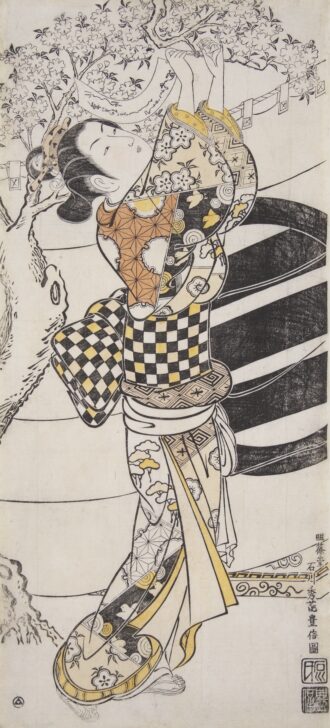Hanging a Poem on a Cherry Tree
Ishikawa Toyonobu

Description
Ishikawa Toyonobu
Japan, 1711–1785
Hanging a Poem on a Cherry Tree
Edo period (1615–1868)
ca. 1746–49
Color woodblock print on paper
Bequest of Margaret Watson Parker, 1955/1.130
During the Edo period, cherry blossom season was one of the few times that upper-class women were permitted to enjoy outdoor amusements. Ladies and their servants would gather under the blossoms to feast on elaborate picnics and play courtly games, concealed from public view by large curtains. In this print, Ishikawa Toyonobu offers the viewer an unhindered view of a beautiful young woman. It is clear from her gorgeous, intricately-patterned kimono
and expensive tortoise-shell hair accessories that she is a daughter of a wealthy samurai (ruling class) family. She is shown hanging a poem card (tanzaku) on a tree just outside the curtain—it is perhaps a love poem intended for someone she expects to pass by.
This print is an urushi-e, meaning "lacquer painting," in which extra glue was used to give the black pigment a lustrous quality. This is a particularly fine example of the print since subtle pink pigment has been applied to the cherry blossoms and the woman’s cheek.
Subject Matter:
During the Edo period, cherry blossom season was one of the few times of year when women of upper class households were permitted to enjoy outdoor amusements. The ladies and their servants would gather under the blossoms to feast on elaborate picnics and play courtly games, all concealed from public view by large curtains. In this print, the artist allows us the voyeuristic pleasure of an unhindered view of a beautiful young woman. From her gorgeous kimono of intricate patterns and expensive tortoise-shell hair accessories, it is clear that she is a daughter of a samurai family. She is shown hanging a poem card (tanzaku) on a tree just outside the curtain—perhaps a love poem intended for someone she expects to pass by.
The verse may be translated as
Once more again in love,
Once more regret--as fleeting
(Adopted from: Maribeth Graybill
“Four Seasons In Japanese Art”: Special Installation of Japanese Gallery at UMMA: Object Labels
July 5, 2003-January 4, 2004)
Physical Description:
A color woodblock print of a young woman hanging a paper with poem on a cherry tree. The woman is in a kimono with intricate design of cherry blossom, hemp leaves, birds and swirls, pine trees and diamond patterns. She also wears broad obi (sash) in checkerboard patterns, which is bow- tied on her back. There is also a white sash underneath the obi, which supports her long kimono. Her hair is tied on the back and adorn with tortoise-shell comb and pin. The cherry tree is in full bloom; there is a curtain with a family crest behind the woman and the tree; a certain kind of platform with swirling vine pattern is peaking below the curtain. The overall color scheme is in yellow, orange, black and white (the color of the paper). There are artist’s signature and two seals on the right bottom corner, and smaller seal on the left bottom corner.
Usage Rights:
If you are interested in using an image for a publication, please visit https://umma.umich.edu/request-image/ for more information and to fill out the online Image Rights and Reproductions Request Form.